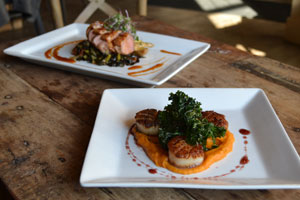Grilling Fruit
Q. What’s the 411 on grilling fruits? I’ve heard peaches are awesome. — Melanie, Grand Chute
A. Grilling fruit is quite easy with a few simple tips. To start, the heat of the grilling process brings out the natural sugars of the fruit and allows it to caramelize, leaving you with a richer and more flavorful product. Be careful not to over-caramelize them. (Note: “Over-caramelizing” is a term we chefs use as a nicer way of saying “burned.” It just sounds better!)
As you begin to experiment with grilling fruit, you may want to select the firm fruits, such as pineapples, bananas, apples and pears. Softer fruits––melons, peaches, plums and nectarines––can also be grilled, but they cook very quickly and easily turn too soft (the culinary term mushé). These varieties, along with oranges and other citrus-type fruits, are best handled by cutting them in thick slices or halves.
Set your grill at a medium heat. To avoid the fruit from sticking and to assist with the development of grill marks, you may want to coat the grilling-face of the fruit with pan spray. Larger pieces can be grilled individually, or fruit kabobs can be prepared using smaller cuts.
Grilling time will vary with each fruit and by the desired doneness. For example, you may want the texture of grilled apples served with pork chops to be somewhat firm, whereas you may want the texture of grilled apples served over ice cream to be significantly softer.
For a final touch, brush the fruit with a marinade before or after grilling. Try lemon or other citrus juice, syrup, jelly or fruit puree, or even your favorite liquor or liqueur. Another technique is to sprinkle a little sugar, such as brown or turbinado, over the fruit just as it finishes.
Picture this: pineapple grilled and golden-brown brushed with a little dark rum and sprinkled with a little brown sugar on it. Oh yeah, baby!











Leave a Comment